Tea Dragons: Autumn Harvest is a card game featuring adorable art and relaxed competitive play. It’s actually the sequel to Tea Dragons and operates the same as the first, like many similar card games of this nature, but features new cards and most saliently four new Tea Dragon decks entirely. I chose Autumn Harvest as it’s the one I’ve actually played, a lovely game I picked up at a game store that was nearly sold out!
TD Autumn is designed by Steve Ellis and Tyler Tinsley and published by Renegade Game Studios. It’s a physical board game, so it’s available to purchase on multiple platforms like Gamestop, Amazon, or the original studio’s website. It’s labeled as being for audiences of ages 10+, which makes sense given it’s maturely written but wholesome, cute, family-friendly thematic.
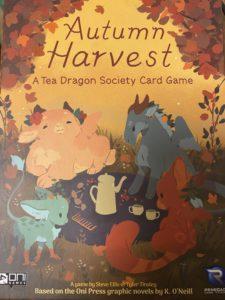
(Tea Dragons: Autumn Harvest external box cover)
In this game, one can play with 2-4 players. I personally played with 3, including myself. The objective is ultimately to end the game with the most Victory Points, which decides the winning player. Hence, at its base TD Autumn is a zero-sum game where the outcome is winning and all others losing or losing. This is made especially clear as there includes a way to tiebreak using the Mentors card, but because this card doesn’t really affect core gameplay, technically using it is optional. Arguably considered a mod, in that sense technically you could also have multiple winners from ties in points. Finally, the game involves two resources: Growth Tokens and Victory Point Tokens. Both can be earned from the effects of various cards. Growth Tokens are more easily attainable and used to purchase other cards, the main “spending” currency. Victory Point Tokens are to keep track of certain Victory Points that players can earn throughout the game, but specifically those gained from items/card effects. Players total their Victory Point score at the end, which includes multiple means of which the VP Tokens are but one.
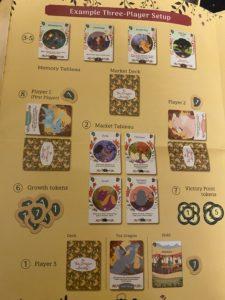
(Game manual example set up)
These different card dynamics can seem a little confusing at first, but the actual procedure to play is fairly simple, so TD Autumn is not too complicated once one is familiar with how cards work. The game starts with several cards in the center of two types, “Market” and “Memory”. Players each choose one of the four pre-built decks to play with: Chamomile, Ginseng, Jasmine, and Rooibos. Then, the game proceeds in a rotating turn fashion, where on their turn a player can choose to either draw or buy a card. In this game, there is no private “hand” – drawing a card means drawing from one’s deck and placing it face-up in front. TD Autumn uses the terminology “hold” instead – so players draw a card and add it to their hold immediately.
“Memory” cards are special as there are a certain set of them for every “Season” – four stages with seasonal flavor, essentially. When the set number of Memory cards have been purchased within a Season, the game proceeds to move to the next stage and replace the array with a number of the new Season’s Memory cards. Other than this, gameplay remains the same, and the rotating turns continue until the final Season is complete. At that point, players can total their points and determine the winner.

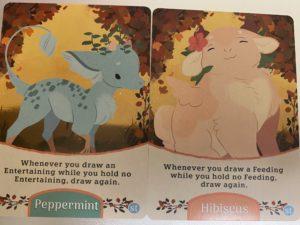
(The four Tea Dragon decks you can play as, with their unique passive effects)
Regarding the four types of game balance, “balance” meaning appropriate challenge level is well-done here. The roles of the cards and different kinds of effects are varied/numerous enough to allow for a bit of complex play, but there isn’t an overwhelming amount. The actual goals are very straightforward – gain tokens, win with aptly named Victory Points. Furthermore, I find a particularly clever part of TD Autumn’s design is the pre-built decks, which has a hand in the game’s balance in multiple ways. For this one, it simplifies the game such that it can be played as a casual social game rather than an intense deckbuilder. Hence, in total I’d say it was well-balanced by this definition. On a similar vein, I’d also say TD Autumn is quite well-balanced in terms of “starting with equal positions and resources” due to the pre-built decks. These decks are essentially one-to-one, with differences being in exact effects (some decks might say Discard X if Y” while others say “Discard Y if Z”, but the numbers are the same such that no one is more likely than the other) and flavor. Basically, TD Autumn is actually a symmetric card game unlike many CCGs, since there’s no deck-building aspect.
Then, we have “balance” in terms of strategies and their relative strengths It’s important that different strategies are about equally viable as players will ignore suboptimal ones if there is a dominant strategy. Once again, the pre-built decks being one-to-one helps by eliminating the factor of constructing a specific strategy in a deck from the ground-up. Players can deckbuild by buying cards in the game to add to their deck, so this means the viability of different strategies depends on what strategies those cards enable. In my particular playthrough, we did have a few different strategies among us three players. One player went for setting up a particularly strong combo, using cards in their hold that allowed them to gain more Growth tokens and also fulfil conditions for another card in their hold to give them card draw. Another player went for the strategy of buying up more items in the Market before going for Memory cards. I personally played it fairly evenly, with one or two cards in my hold to gain bonuses, buying an item or two occasionally, and focusing on getting the exact Memory card I wanted first. These were all quite viable strategies, and I found the game cleverly designed for enabling such subtle but effective differences.
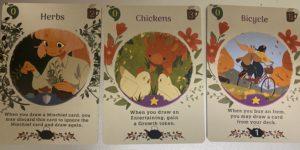
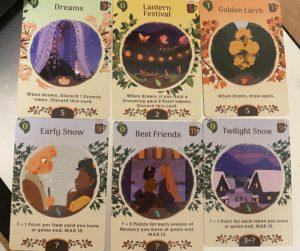
(Left: examples of Market cards; Right: examples of Memory cards, showing seasons and the multiple end-game Winter effects)
Finally, TD Autumn is also pretty balanced in terms of game objects having the same cost/benefit ratio. The game does this pretty well with the main way being transitively balancing item cards, as better cards cost more Growth Tokens to acquire at a consistent curve. There isn’t really a need for intransitive balancing as each deck has its own flavors of Grooming, Feeding, Sleeping, and Entertaining and they don’t “compete” with each other. Rather, gameplay revolves around interacting with one’s own deck and resource competition in buying Market item cards. Finally, there an argument can be made for balancing the Memory cards in a fruity way, specifically the Winter ones. As they are meant to sort of be an end game effect counter, they feature somewhat different effects that can’t really be compared, because they cost similarly and are better/worse for different players depending on the strategy they’ve adopted thus far.
A critique I might have for the game stems from how in the playthrough, one would sometime want to buy a Market item but didn’t want another person to get a particular Memory card. I think having this strategic tradeoff is fine overall, but it’s a bit too suboptimal to ever go with the item as buying the item depletes both a turn and Growth Token resources needed. In other words, I felt the delay cost from buying Market cards was a little too strong. This could be tweaked in a minor way, for instance by increasing the cost of Memory cards so that it takes more turns to achieve them for all players and there is more time for a Market item purchase to make up for its tempo loss.
 (Overall game box, internal)
(Overall game box, internal)
Tea Dragons: Autumn Harvest achieved its types of fun in Challenge, Narrative, and Fellowship – there was room for pursuing different strategies, enjoying the storytelling a la art and card text (not to mention the great weaving of game structure with making narrative sense, as with stages progressing via “seasons”), and casually socializing while still feeling like I had a goal in the game. The relaxed nature of the gameplay meant it felt much more like friends engaging in a narrative journey together while playing, and simple turn actions gave ample room for conversation. Random card draw luck would lead to variance in who seemed to be winning, but the smaller and equally balanced decks made it not feel frustrating or unfair, and usually by nature of the the build decks, the luck would come back around in some way. Overall, I loved this game because, aside from the beautiful art, it was balanced in a way that made playing truly feel good.


